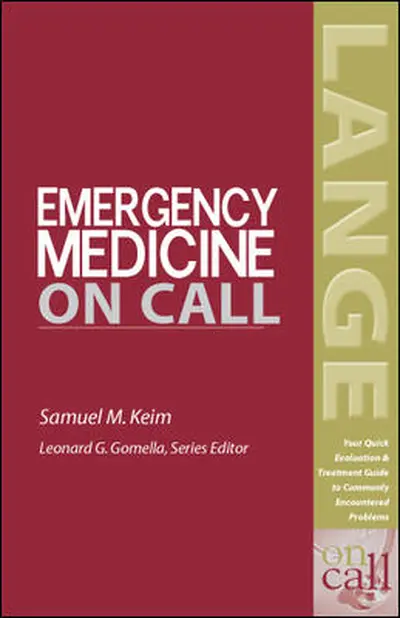My Account Details

ISBN10: 0071388796 | ISBN13: 9780071388795

Step 1 . Download Adobe Digital Editions to your PC or Mac desktop/laptop.
Step 2. Register and authorize your Adobe ID (optional). To access your eBook on multiple devices, first create an Adobe ID at account.adobe.com. Then, open Adobe Digital Editions, go to the Help menu, and select "Authorize Computer" to link your Adobe ID.
Step 3. Open Your eBook. Use Adobe Digital Editions to open the file. If the eBook doesn’t open, contact customer service for assistance.
Publisher's Note: Products purchased from Third Party sellers are not guaranteed by the publisher for quality, authenticity, or access to any online entitlements included with the product. This user-friendly reference assists in the initial evaluation and treatment of the most frequently encountered problems in emergency medicine, both common and potentially life-threatening. The largest section of the book consists of 97 of the most common or important emergency medicine problems experienced by adult, pediatric, and geriatric populations. Each chapter in this section includes the presenting problem, immediate questions, differential diagnosis, laboratory and diagnostic data, and treatment plan. Additional chapters such as toxicologic emergencies, laboratory diagnosis, procedures, blood component therapy, and commonly used medications are also included and enhance the book's value as a single-source reference. Key Features: *Logically organized, quick-access reference to the evaluation and management of problems encountered in the emergency department setting - essential information is located immediately and provides a complete picture of the initial evaluation and treatment of specific problems *Problem-oriented approach to the information is uniquely suited to the way in which emergency medicine is taught and practiced *Differential diagnosis, key laboratoy and diagnostic tests, and treatment plans for 97 of the most commmon problems that present in the emergency department *Chapters on laboratory and diagnostic tests, procedures, and commonly used medications - highlight important information in the management of the medical patient
I. Adult Emergency On-Call Problems
1. Abdominal Pain
2. Acid-Base Disorders
3. Altered Mental Status
4. Altitude Sickness
5. Anaphylaxis
6. Aneurysms
7. Anxiety
8. Back Pain
9. Bites and Stings
10. Bleeding Problems
11. Bradycardia
12. Cancer Problems
13. Cardiac Arrest
14. Cardiac Transplant Problems
15. Chest Pain
16. Congestive Heart Failure/Pulmonary Edema
17. Consent to Treatment
18. Constipation
19. Cough in Adults
20. Decubitus Ulcer
21. Dental Pain and Infections
22. Dermatologi Problems
23. Diabetic Problems
24. Dialysis Patient Problems
25. Diarrhea
26. Dizziness and Vertigo
27. Drowning/Near Drowning
28. Earache
29. Epistaxis
30. Ethical Dilemma
31. Eye Pain/Red Eye
32. Fever in Adults
33. Foreign Body in Rectum
34. Gastrointestinal Bleeding
35. Gastrointestinal Catheter Problems
36. Genitourinary Catheter Problems
37. Headache
38. Heart Murmur
39. Hemophysis
40. Hemorrhagic Shock
41. Hernia
42. Hiccups
43. Hypertension
44. Hostile Patient
45. Hypertension
46. Hyperthermia
47. Hypotension
48. Hypothermia
49. Indwelling Catheter Problems
50. Jaundice
51. Joint Swelling
52. Pacemaker Problems
53. Palpitations
54. Paresthesias
55. Penile Problems
56. Pregnancy Problems
57. Psychiatric Problems
58. Respiratory Distress
59. Scrotal Problems
60. Seizure
61. Sepsis
62. Sexual Assault
63. Skin Infections
64. Sore Throat
65. Stroke/TIA
66. Swollen, Warm, or Cold Extremity
67. Syncope
68. Tachycardia
69. Transfusion Reactions
70. Urinary Tract Problems
71. Vaginal Bleeding/Discharge
72. Weakness
73. Wheezing in Adults
II. Pediatric On-Call Problems
1. General Pediatric Assessment
2. Abdominal Pain in Children
3. Acute Life-Threatening Event (ALTE)
4. Cough in Children
5. Ear Pain in Children
6. Febrile Infant
7. Irritable Child
8. Musculoskeletal Problems in Children
9. Nonaccidental Trauma in Children
10. Swallowed Foreign Body
11. Vomiting and Diarrhea in Children
12. Wheezing in Children
III. Trauma Emergency On-Call Problems
1. Trauma Assessment and Resuscitation
2. Blunt Abdominal Trauma
3. Blunt Head Trauma
4. Burns
5. Chest Trauma
6. Electrical Injury
7. Extremity Fractures and Dislocations
8. Eye Trauma
9. Facial Trauma
10. Genitourinary Trauma
11. Neck and Spinal Cord Trauma
12. Needlestick
13. Pelvic and Hip Trauma
14. Trauma in Pregnancy
IV. Geriatric Emergency On-Call Problems
1. General Geriatric Assessment
2. Acute Myocardial Infarction in the Older Patient
3. Altered Mental Status in the Older Patient
4. Elder Abuse
5. Falls in the Older Patient
6. Functional Decline
V. Common Toxicologic Emergency On-Call Problems
1. Acetaminophen
2. Alcohols
3. Amphetamine Overdose
4. Anticholinergic Poisoning
5. Benzodiazepine Overdose
6. Beta Blocker Overdose
7. Calcium Channel Blocker Overdose
8. Cardiac Glycoside Overdose
9. Caustic and Corrosive Ingestion
Need support? We're here to help - Get real-world support and resources every step of the way.